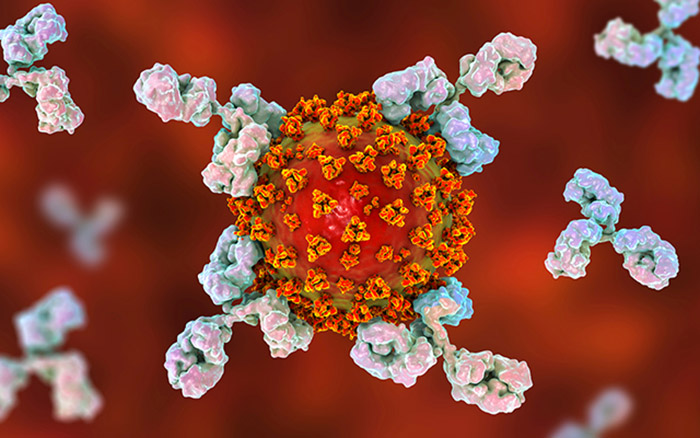
By:
- Alicia Clarke
Published Date
By:
- Alicia Clarke
Share This:
New Algorithm Analyzes the Genetic Building Blocks of Immunity
It could help determine why a potential COVID-19 vaccine may be effective in some people but not others

Image credit: Shutterstock/Kateryna Kon
Scientists with UC San Diego’s Jacobs School of Engineering and the Qualcomm Institute have developed a new gene prediction algorithm, called MINING-D, that could help researchers investigate the genetic clues behind the variation of symptoms shown in COVID-19 patients — information that is key to creating a versatile and effective vaccine.
The findings and algorithm, which were published in PLOS Computational Biology on April 27 may give scientists a more comprehensive view of how the genes that form the foundation of our immune system create a personalized repertoire of antibodies to protect against invading pathogens. They may also shed light on why some people have a more effective immune response to an infection.
“This study will be particularly helpful as dozens of groups begin testing potential COVID-19 vaccines, and see that the vaccine works on some people and not on others—and the secret may be in the mutations in each individual’s immune system,” said Pavel Pevzner, a professor with UC San Diego’s Department of Computer Science and Engineering and co-author on the paper. “Without knowing the immune makeup of an individual, we won’t be able to say why it worked or didn’t work. MINING-D may help provide answers.”
There are three groups of core immunoglobulin genes that are the building blocks of an individual’s immune response: the variable (V), diversity (D) and joining (J) germline genes. MINING-D analyzes how those blocks, particularly the lesser-studied D gene, are shuffled and repackaged to create a large variety of antibodies. D genes play a critical role in creating the regions of antibodies that are responsible for recognizing pathogens.
“MINING-D will help researchers study mutations in D genes, which up until this point has been a challenge,” said Vinnu Bhardwaj, the paper’s lead author and a Ph.D. candidate with the Department of Electrical and Computer Engineering and Qualcomm Institute at UC San Diego. “Our initial study revealed that some variants of D genes are used more often than others in response to various infections. We hope this information will pave the way to unlocking clues about the role the D genes play in how difficult or easy it is for a patient to fight infection.”
When a pathogen enters a healthy organism, it triggers an immune response that includes recombination of the germline genes and their random mutations. The process, which differs from individual to individual, results in roughly a billion antibodies circulating in each of us at any given moment. This personalized antibody repertoire is constantly changing to fight new infections.
“Our next step is to collaborate with leading immunogenomics experts at University of Louisville who are starting to sample antibody repertoires in patients with varying severity of COVID-19,” said Yana Safonova, paper co-author and postdoctoral researcher in the Department of Computer Science and Engineering.
Safonova points out that, as in the case of flu, earlier studies showed a single mutation in a gene called IGHV1-69 resulted in an individual’s reduced ability to recognize the flu virus and thus a failure to produce an immune response against it.
“Understanding similar genetic variations among COVID-19 patients may be the key to developing versatile vaccines that trigger the development of antibodies that recognize and neutralize the SARS-CoV-2 virus,” Safonova said.
Collaboration Spurs Innovation
The idea for MINING-D took shape several years back when Safonova, a bioinformatics researcher and postdoctoral fellow at the time with the Qualcomm Institute’s Information Theory and Applications Center, started working with Bhardwaj, a Ph.D. candidate with an applied machine learning and data science background. They discussed the idea of developing an algorithm to study the genetic puzzle that is the foundation of our immunity. From there, the two paired their skill sets to create research they hope will have a lasting impact.
In addition to Pevzner, Safonova and Bhardwaj worked closely with Qualcomm Institute Director Ramesh Rao and Massimo Franceschetti, a professor with the Department of Electrical and Computer Engineering. Rao and Franceschetti are co-authors on the paper and also co-advise Bhardwaj.
“At the heart of this research is the topic of ‘string matching,’ where one seeks to efficiently and accurately infer the whole based on awareness of its parts. This problem emerges in many different contexts including spell checkers, malware detection and pattern recognition in general,” Rao explained. “This collaboration illustrates how solutions to a well abstracted problem have the potential to impact numerous applied fields. Pavel, Massimo and I couldn't be more delighted to see the development of this boundary-crossing collaboration.”
“Our work is a wonderful example of how engineering insight can be successfully applied to biological problems, and once again it shows how the Jacobs School and QI provide fertile grounds for cross-disciplinary innovation,” Franceschetti said.
Share This:
You May Also Like
Stay in the Know
Keep up with all the latest from UC San Diego. Subscribe to the newsletter today.


